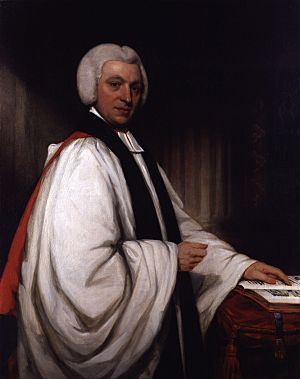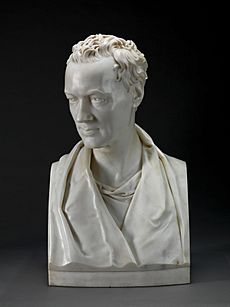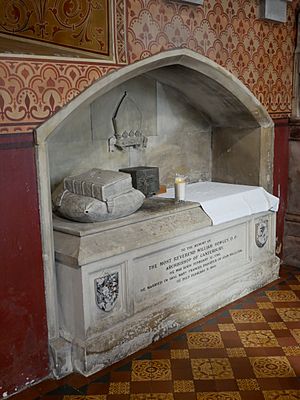William Howley facts for kids
Quick facts for kids The Most Reverend and Right Honourable William Howley |
|
|---|---|
| Archbishop of Canterbury | |

Portrait by William Owen
|
|
| Province | Canterbury |
| Diocese | Canterbury |
| See | Canterbury |
| Enthroned | 1828 |
| Reign ended | 1848 |
| Predecessor | Charles Manners-Sutton |
| Successor | John Bird Sumner |
| Orders | |
| Consecration | 10 October 1813 by Charles Manners-Sutton |
| Personal details | |
| Born | 12 February 1766 Ropley, Hampshire, England |
| Died | 11 February 1848 (aged 81) Lambeth, Surrey, England |
| Buried | St Mary the Blessed Virgin Church, Addington, London |
William Howley (born February 12, 1766 – died February 11, 1848) was an important leader in the Church of England. He held the top position of Archbishop of Canterbury for 20 years, from 1828 to 1848.
Contents
Who Was William Howley?
William Howley was a significant figure in the Church of England during the 19th century. He served as the Archbishop of Canterbury, which is the senior bishop and main leader of the Church of England. This role is very important in the UK.
Early Life and Education
William Howley was born in 1766 in a place called Ropley, in Hampshire, England. His father was a vicar there, which is a type of priest. William went to a well-known school called Winchester College.
In 1783, he continued his studies at New College, Oxford University. He became a chaplain to a noble person, the Marquess of Abercorn, in 1792. This connection helped him a lot in his early career. Later, in 1809, he became a professor at Oxford University.
Becoming a Bishop and Archbishop
In October 1813, William Howley became the Bishop of London. This was a very important position in the church. He served as the Bishop of London until 1828.
After that, he was chosen to be the Archbishop of Canterbury. This is the highest position in the Church of England. He held this role for 20 years, until he passed away in 1848.
Archbishop During Big Changes
William Howley was Archbishop during a time of major changes in Britain. These changes included new laws about who could hold public office.
- The Sacramental Test Act of 1828: This law removed old rules that stopped people who were not part of the Church of England from holding government jobs.
- The Roman Catholic Relief Act of 1829: This law gave Roman Catholics more rights, including the right to sit in Parliament.
- The Great Reform Act of 1832: This law changed how people voted and gave more people the right to vote.
Many bishops, including Howley, were against these new laws. As the Archbishop, Howley often spoke for the bishops. Because he strongly opposed the Great Reform Act, his carriage was even attacked in Canterbury.
Coronations and Queens
Archbishop Howley had the important job of leading two royal coronations.
Coronation of William IV
In 1831, he led the coronation ceremony for King William IV and Queen Adelaide. This was a grand event where the new King and Queen were officially crowned.
Informing Queen Victoria
On June 20, 1837, at 5:00 AM, Archbishop Howley went to Kensington Palace. He was there to tell Princess Victoria that her uncle, King William IV, had died. This meant she was now the Queen of the United Kingdom.
He also led Queen Victoria's coronation ceremony on June 28, 1838. This was another very important event in British history.

Interest in Buildings
William Howley was very interested in architecture, which is the design of buildings. During his time as a church leader, he oversaw many building projects.
He helped renovate and rebuild several important church buildings. These included his official home at Oxford and his residence in London when he was Bishop. He also oversaw major renovations at Fulham Palace.
One of his biggest projects was the extensive renovation of Lambeth Palace. This is the official London home of the Archbishop of Canterbury. The work started after 1828 and was done in a style called Gothic Revival. It was a huge project that took many years to complete.
Family Life
William Howley married Mary Frances Belli on August 29, 1805. They had two sons and three daughters. Sadly, neither of their sons lived to be adults. One of his daughters married a relative of a famous artist.
William Howley passed away in 1848, just before his 82nd birthday. He was buried in Addington, London, after a large funeral.
Images for kids




